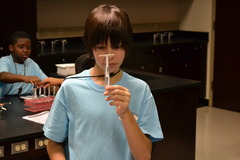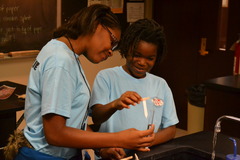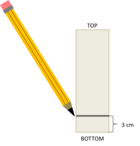Calling all Investigators! The STEM-Works team from SMU needs your help with a paper chromatography lab at the 2012 USA Science and Engineering Festival. Join us at the Kids Ahead booth (booth #3323) April 27th - 29th, 2012 to participate in this activity.

Chromatography is a method of separating out materials from a mixture and can be used in forensic science to determine what type of marker or pen was used to write a crime scene note. Since ink is a mixture of several dyes we can separate those colors from one another using chromatography. When ink is exposed to certain solvents the colors dissolve and can be separated out. When we expose a piece of paper with ink on it to a solvent, the pigment travels up the paper as the water is absorbed by the paper - so awesome!

Follow the instructions below so you can do your own paper chromatography lab at the Kids Ahead booth (#3323) or practice this forensic science technique at home.
Equipment (only needed if practicing at home):
1 Black marker
1 Strip of chromatography paper
Popsicle stick
Tape
Test tubes and racks (or cups)
Paper towels
Water
Pencil
Ruler
Activity:
1. Put 2-3 ml of water into a test tube or cup.
 2. Using your ruler, measure and draw a straight line 3 cm above the bottom of the strip of chromatography paper. (See the image to the right for an example)
2. Using your ruler, measure and draw a straight line 3 cm above the bottom of the strip of chromatography paper. (See the image to the right for an example)
3. Using the black marker place a small dot on the center of the pencil line.
4. Wrap the top 1 cm of the chromatography paper around a popsicle stick and tape it so that it stays in place.
5. Write the brand of the marker on the popsicle.
6. Without submerging the pencil line, slowly lower the chromatography strip into the test tube so the tip of the paper is barely in the water. Rest the popsicle stick on top of the test tube. It is VERY important that the sample dot stay above the water.
7. You will begin to see the water travel up the paper. This is called capillary action. As the water is drawn up, it will carry the pigments in the sample up the strip at different rates.
9. When the water is 1 cm from the popsicle stick, remove the strip from the test tube and lay on a paper towel to dry.
10. Write down your observations and if you have different types of markers, you can repeat this exercise and compare the different chromatographs.



















What other people thought